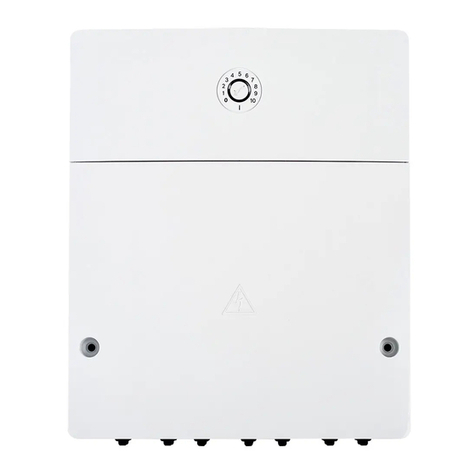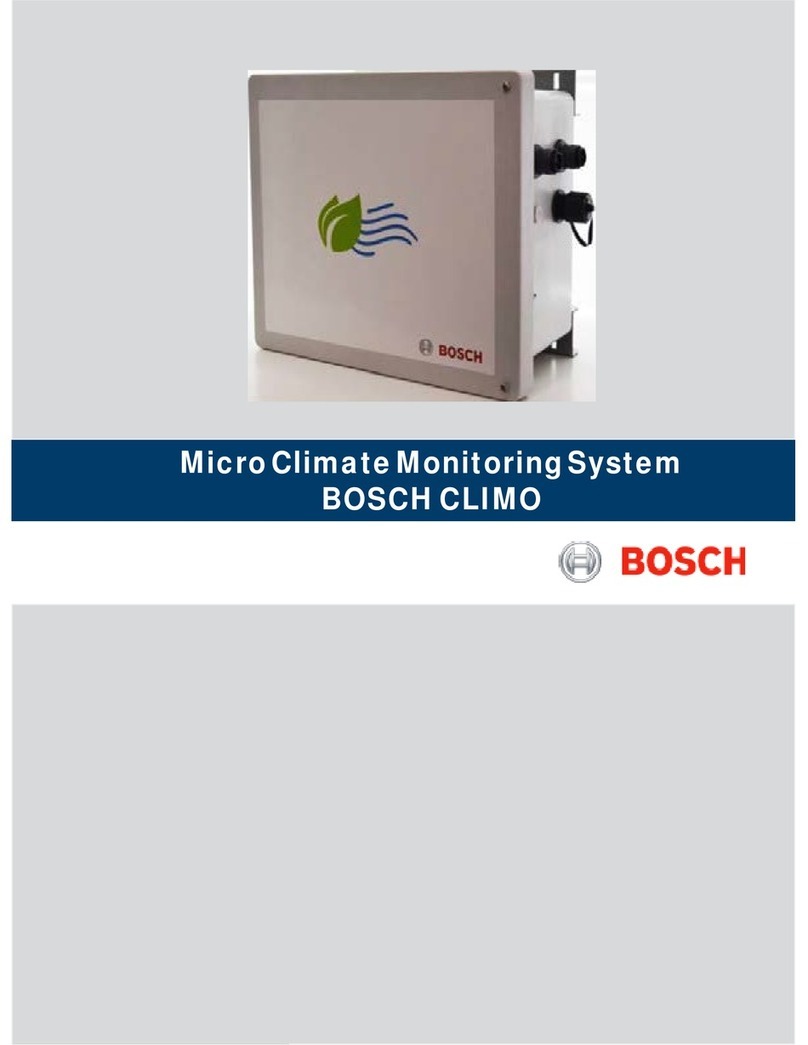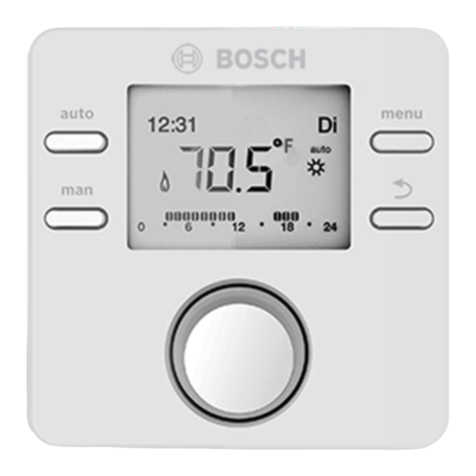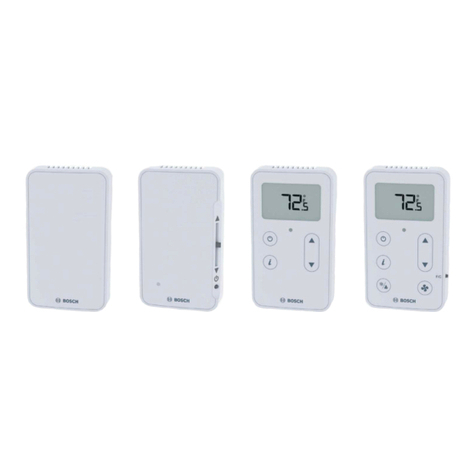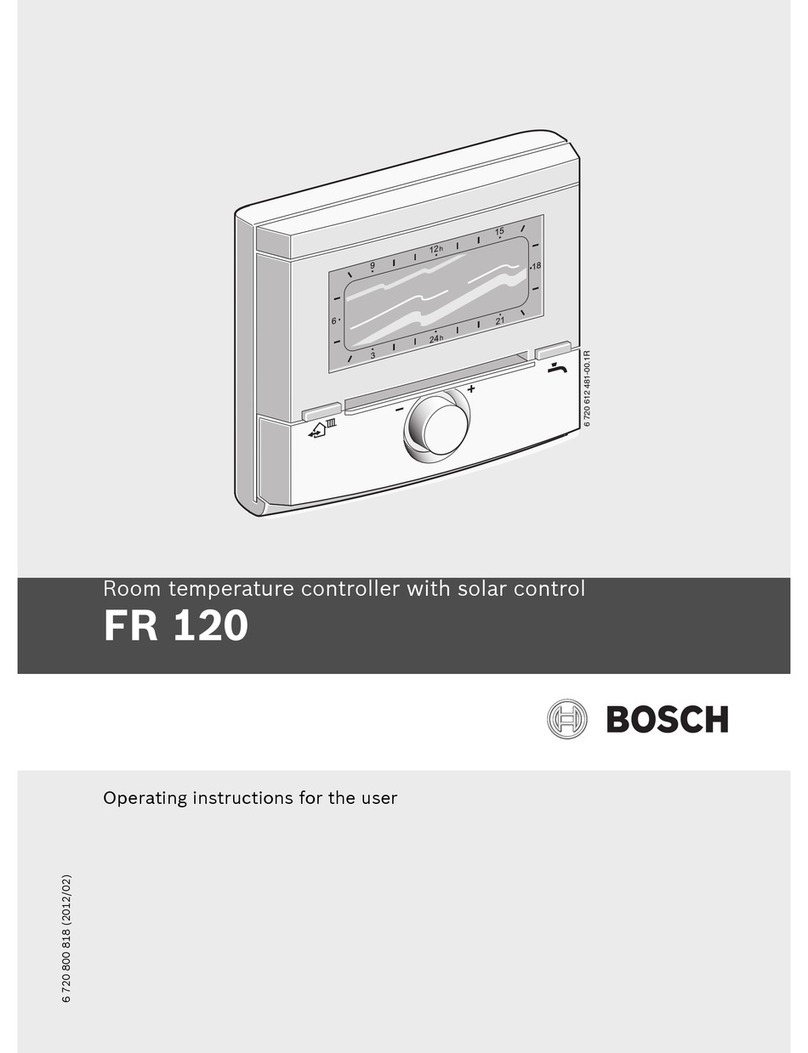
6
|Checking and Replacing Temperature Sensors Technical Service Bulletin
Data subject to change without notice | Printed in the USA | BTC 740002303 B |05.2011 BOSCH THERMOTECHNOLOGY CORP.
Bosch Thermotechnology Corp.
50 Wentworth Avenue
Londonderry, NH 03053
Tel: 1-800-283-3787
Fax: 1-603-584-1687
www.bosch-climate.us
2
Figure 3
3. Close hot water faucet and return to the heater immediately.
Press and hold the program ( ) button while pressing the On/
Off button to the On position.
4. Release the program ( ) button when '188' appears on the
display. The display should read 'P2'. If not, repeat process.
5. Press the ( ) button on the control panel until the display reads
'P4'. You are now in the diagnostic mode of the control unit.
6. Press the program ( ) button and the display should read 'E'.
7. Use the ( ) and ( ) buttons on the control unit to scroll
through the different diagnostic modes. Scroll to diagnostic
mode 1d to access inlet water temperature reading and
diagnostic mode 2d to access outlet water temperature reading.
8. Once in the selected diagnostic mode of your choice, press the
( ) button to display the diagnostic information.
9. Diagnostic temperature readings should be within ±5°F of the
reading taken at the faucet with thermometer. If not, continue
with steps below.
10. Unclip the wire connection from the cold water sensor.
(Fig. 3, pos. 1)
11. Press the On/Off button on the heater to "Off". Reopen hot
water faucet and let water flow for 3-5 minutes. Place a multi-
meter (set on kilo-ohms (k))on the two pins inside the wire
connector coming from the cold water sensor.
Inlet temperature sensor readings Table 1
Temperature Approximate resistance reading
32 °F 24 k
42 °F 19 k
52 °F 15 k
62 °F 12 k
72 °F 9.5 k
82 °F 7.5 k
92 °F 6.25 k
102 °F 5 k
112 °F 4.25 k
12. Compare resistance reading with the coordinating temperature
in Table 1. This should be the same temperature (±5°F) as the
reading taking at the faucet with the thermometer.
13. If readings do not match up, sensor may be defective and should
be replaced.
14. With water still running out of a hot water tap, remove wires
from spade connections on hot water sensor (Fig. 3, pos. 2).
15. Place a multi-meter (set on kilo-ohms (k))on the two spade
connections of the hot water sensor.
16. Compare resistance reading with the coordinating temperature
in Table 2. This should be the same temperature (±5˚F) as the
reading taken at the faucet with the thermometer.
Outlet temperature sensor readings Table 2
Temperature Approximate resistance reading
32 °F 36 k
42 °F 28 k
52 °F 21 k
62 °F 17 k
72 °F 13 k
82 °F 10 k
92 °F 8.5 k
102 °F 7 k
112 °F 5.5 k
17. If readings do not match up, sensor may need to be cleaned or
may be defective. Follow steps below to clean the hot water
sensor and then retest sensor with multi-meter. If readings are
still inconsistent, replace sensor.
Cleaning and/or replacing hot water temperature sensor
1. Unclip temperature sensor from the copper pipe. Wipe the
inside face of the sensor clean with a pencil eraser where it
makes contact with the copper pipe. Wipe down the section of
copper pipe where sensor is placed with a clean rag.
2. Clean and polish spade connections on hot water sensor with
emery cloth.
3. Clip the cleaned or new hot water sensor firmly on to the hot
water outlet pipe. (Fig. 3, pos. 2). Verify the sensor is making
good contact with the copper pipe.
4. Reconnect wires to spade connections on hot water sensor (no
polarity). Ensure spade connectors are fully seated.
5. If sensor was not a new replacement, retest with multi-meter
following the procedure above.
6. If readings are now constistent with Table 2 or replacement
sensor is new, replace combustion and front covers and power
cord.
7. Push On/Off button to "ON" and return heater to service.





